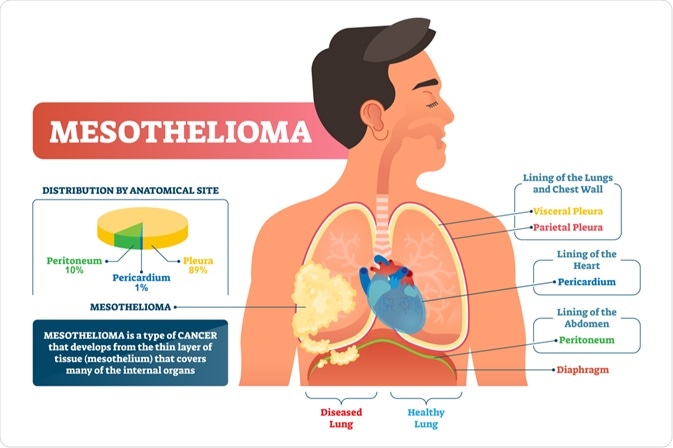Malignant mesothelioma represents an uncommon disease that is often associated with occupational asbestos exposure, with a steady increase in its incidence worldwide. Mesotheliomas are almost universally considered a fatal malignancy and, until recently, the treatment options were limited and often ineffective.

Image Credit: VectorMine / Shuttertstock.com
Current treatment modalities for malignant mesothelioma can be classified into radiotherapy, chemotherapy, and radical procedures, such as surgery. Palliative measures are also often employed with the primary aim to remove pleural effusions and prevent their recurrence; therefore, symptoms such as chest pain and dyspnea, the latter of which occurs in cases of pleural mesothelioma, can be relieved.
Radiotherapy
Radiotherapy is frequently used to control local tumor growth. An occasional regression of the disease can be seen following radiation treatments, although there is no evidence that radiotherapy alone can affect survival rates. Therefore, radiotherapy is usually used as a part of the multimodal approach, most often combined with surgery.
When administering radiotherapy as adjuvant therapy after surgical extrapleural pneumonectomy or pleurectomy/decortication, patients are usually treated with conventional radiation techniques using anterior and posterior fields that encompass the entire part of the diseased lungs.
Highly complex intensity-modulated radiation therapy (IMRT) techniques allow for a more effective sparing of normal tissues, thus providing safer and less toxic treatment with better efficacy. IMRT also utilizes higher radiation doses that are delivered to the tumor target. Both arc therapy and helical tomotherapy are rotational radiotherapeutic methods that deliver radiation from a greater number of beam angles.
Radiation therapy has a limited role in peritoneal mesothelioma; therefore, it is not used in most medical centers for treating this condition. The treatment for advanced primary pericardial mesothelioma is usually palliative due to the presence of tumors that are often resistant to radiotherapy and chemotherapy.
Chemotherapy
Monotherapy with single cytotoxic drugs seldom gives a significant result in the treatment of malignant pleural mesothelioma; however, combination regimens with novel drugs and standard molecules are showing better clinical responses and benefits. According to the results of phase II/III studies, pemetrexed, which is a multitarget folate pathway inhibitor, in combination with platinum derivatives and the cisplatin/gemcitabine associations represent front-line chemotherapy.
Vinorelbine as a single agent and when combined with mitomycin C, vinblastine, and cisplatin, has also been validated as a good symptom relief approach with acceptable toxicity. Histone deacetylase inhibitors and antiangiogenic agents also show noteworthy promise as targeted therapies but have not yet reached daily practice.
Chemotherapy has an important role in the palliative care of peritoneal mesotheliomas. Moreover, chemotherapy can be administered systemically or directly into the abdomen, with continuous hyperthermic peritoneal perfusion showing the best response rate of 84.6%. The most studied chemotherapeutic agent used in the treatment of mesothelioma is cisplatin with proven activity in about 25% of all patients.
New Wearable And Portable Treatment For Mesothelioma
Surgery
When used in the treatment of malignant pleural mesothelioma, the primary goal of surgery, taking into account the framework of a multimodal approach, is the resection of all macroscopic lesions and the delivery of chemotherapy radiation. The surgical options available to attain this goal include extrapleural pneumonectomy, pleurectomy/decortication, and, in some instances, surgical pleurodesis via video-assisted thoracoscopic surgery.
Some medical centers recommend pleurectomy/decortication as a method of choice for patients with compromised lung/heart function and those of an older age and/or with certain comorbidities. In the patients who are ideal candidates for this procedure, surgeons are often able to remove the bulk of the tumor while sparing pulmonary function.
Appropriate knowledge of the similarities and differences between all of the aforementioned techniques is pivotal in understanding the complex issues surrounding the patient selection, adequate diagnosis, staging, preoperative assessment, perioperative management, as well as adjuvant treatment.
Cytoreductive surgery followed by intraperitoneal hyperthermic perfusion represents a standard approach for resectable peritoneal mesotheliomas. Pericardiectomy can be attempted for pericardial mesothelioma; however, the procedure is often unsuccessful because the pericardium can be densely adherent to the myocardium.
References
Further Reading